Card Counting the Super Sevens Blackjack Side Bet
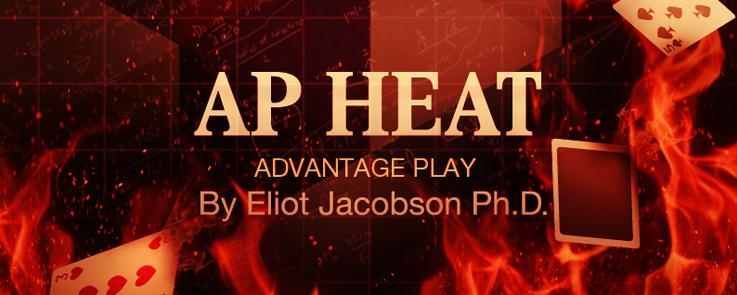
One of my first outings as a novice blackjack card counter was to Laughlin, Nevada, in the Spring of 1997. I recall seeing a wager on a six-deck shoe game called the Super Sevens (SUP7) side bet. It paid whenever the first card dealt was a seven, with higher payouts for two or three sevens and suited hands. This was my first experience with advantage play against a side bet. I did some scratch mathematics and determined that if twenty non-7’s came out at the start of the shoe, then I had the edge. That “special” shoe finally arrived and I started making SUP7 wagers. I recall a hand when sevens were dealt around the table, missing me entirely.
I haven’t seen SUP7 in a casino in about 15 years. I thought it was extinct. But recently it has been popping up again. A Google search shows three U.S. land-based casinos that offer the SUP7 wager. One casino web page advertises: “A brand new side bet for Blackjack lovers … look for specially marked tables.” Online casinos have also started to resurrect this dinosaur.
SUP7 pays based on the number of sevens dealt to the player, starting with his first card. If the player’s first card is not a seven, the player loses. Otherwise, it is simply a question of counting the number of sevens from there. There are two important clarifications:
- If the player is dealt two sevens and the dealer has blackjack, then the player is dealt an additional card to complete the action on the SUP7 bet.
- If the player is dealt two sevens and splits, then the first card dealt to the first split seven is used to complete the action on the SUP7 bet.
The following table gives the combinatorial analysis for SUP7:
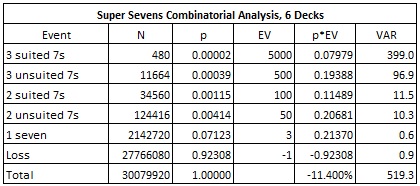
In particular:
- The house edge for SUP7 is 11.400%.
- The standard deviation for SUP7 is 22.8.
- The hit frequency for SUP7 is 7.692%.
It should be intuitively obvious to the casual reader of this blog that SUP7 can be crushed by card counting. The problem with this gold-mine is that the only wager the player is allowed to make is $1 (one dollar). No matter the edge the AP can get, with this austere limitation on wager size, SUP7 will never be a viable advantage play. From the casino side, the income per $1 wager is only about 11 cents. Given the time/motion tradeoff, the profitability of SUP7 for the casino is surely in doubt. I expect that if SUP7 continues its comeback, the maximum wager will increase.
The following combinatorial analysis shows the edge when twenty non-7s are removed from the start of a fresh six-deck shoe:
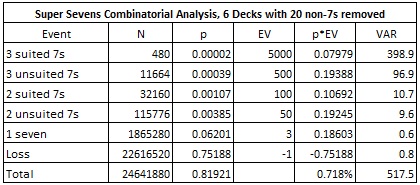
In this case, SUP7 gives an edge to the player of 0.718% over the house.
The probability that the first twenty cards in a fresh shoe are non-7s is 20.72%. It follows that about one-in-five shoes will give the AP an edge after about the second or third round. That "rare shoe" back in Laughlin in 1997 was not so rare after all. (Note. If the first nineteen cards in a fresh shoe are non-7s, then the player has an edge of 0.163% over the house. This situation occurs on 22.57% of fresh six-deck shoes. At the eighteen card point, the house still has the edge.)
I am going to forgo the usual EOR analysis for determining the card counting tags. The obvious card counting system must be the right system:
- Seven = -12
- All other ranks = +1.
The previous combinatorial analysis corresponds to a true count of just under +4 using this card counting system.
The following table gives the results of a simulation of one billion (1,000,000,000) six-deck shoes, with the cut-card placed at 260 cards (52 cards from the end):
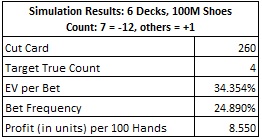
As expected, this simulation gave a target true count of +4.
The win-rate of 8.550 units per 100 hands is the largest win-rate of any side bet I have analyzed that doesn’t require team play. Only team play against the Slingo Bonus Bet blackjack side bet gives a higher overall return. But for the fact that the maximum wager is $1, SUP7 would surely be a big target.
To underscore the extraordinary vulnerability of SUP7 to card counting, I created a graph that plots the edge as a function of the true count. The graph below was produced by a simulation of one billion (1,000,000,000) six-deck shoes, using the count system given above. The horizontal axis corresponds to positive true counts. The vertical axis gives the approximate house edge at the given true count.
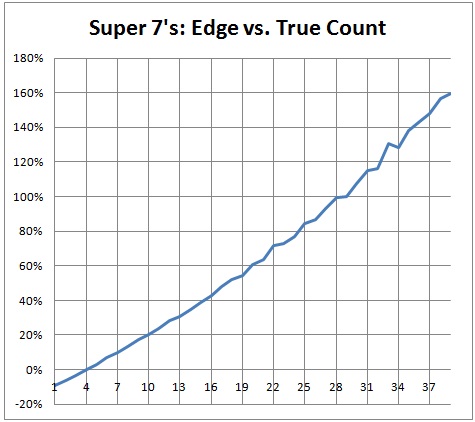
Note that for counts less than +4, the graph is below the axis, indicating a house-edge. But, as the true count increases, the player-edge on SUP7 rises to extreme values. At a true count of +29, the player-edge exceeds 100% over the house.
For completeness, here is the combinatorial analysis and card counting data for SUP7 when dealt from an eight-deck shoe.
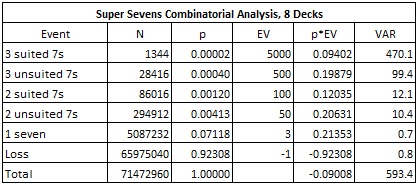
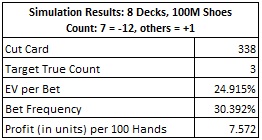
The following are my recommendations for protecting the SUP7 blackjack side bet from advantage play:
- Maintain the $1 maximum bet, or
- Do not offer SUP7 in your casino.


